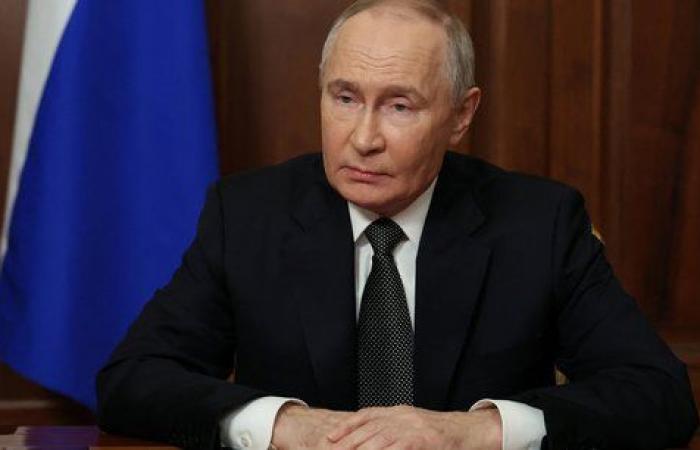The Russian president once again brandishes the threat of the Orechnik. He said Thursday that he did not rule out ordering a new strike against the Ukrainian capital kyiv with its experimental hypersonic missile.
“We do not exclude the use of Orechnik against military targets, military-industrial installations or decision-making centers, including in kyiv”he said during a press conference broadcast on Russian television on the sidelines of a visit to Kazakhstan.
Vladimir Putin took the opportunity to once again praise the capabilities of his latest generation missile. “It is not an atomic weapon because it is A- high precision and B- not equipped with a nuclear explosive charge, and does not pollute the environment. But from a power point of view, it’s comparable”said the Russian president. He had already compared this missile to “a meteorite” and the heat released at the time of the explosion at the temperature of the surface of the Sun.
MBDA close to signing a giant Mistral order (more than 1,500 missiles)
Here is what we know about this experimental missile, whose name means “hazel” in Russian.
Targets between 3,000 and 5,500 km
According to Vladimir Putin, it is a ballistic missile “intermediate range”which can reach targets between 3,000 and 5,500 km. A high-ranking source in the Ukrainian General Staff said Russia only has “a few units”. The Orechnik therefore does not fall into the category of intercontinental missiles (with a range of more than 5,500 km). But, if fired from the Russian Far East, it could theoretically hit targets on the US West Coast.
“The Orechnik can (also) threaten almost all of Europe”noted Pavel Podvig, researcher at the United Nations Institute for Disarmament Research (Unidir) in Geneva (Switzerland), in an interview with the Ostorozhno Novosti media.
Until 2019, Russia and the United States could not field such missiles, under the Intermediate-Range Nuclear Forces (INF) Treaty signed in 1987 during the Cold War. But in 2019, US President Donald Trump withdrew Washington from this text, accusing Moscow of violating it, which opened the way to a new arms race.
“The Russians are also very active elsewhere than in Ukraine” (General Philippe Adam)
On November 22, during a televised meeting with military officials, Vladimir Putin assured that Moscow had a reserve of these missiles “ready to use”. He also claimed that its mass production had “started”.
Nuclear charge
Vladimir Putin did not specify whether this missile was exclusively conventional or whether it could be equipped with a nuclear charge. What he had in any case hinted at last week after a test strike in Ukraine. The latter was presented as a response to American ATACMS and British Storm Shadow missile launches on Russian soil. “If you use several of these systems in one strike – two, three, four – then, in terms of its power, it is comparable to the use of a nuclear weapon”he nevertheless clarified this Thursday.
According to Vladimir Putin, the Orechnik missile, fired on November 21 without a nuclear charge, can reach the speed of Mach 10, “i.e. 2.5 to 3 kilometers per second” (approximately 12,350 km/h). According to Ukrainian military intelligence (GUR), the speed reached by the missile “on the final part of the trajectory” was “greater than 11 Mach” (environ 13.600 km/h).
“The temperature of the impacting elements reaches 4,000°C”Vladimir Putin boasted on Thursday, almost as much according to him as“on the surface of the sun”between “5,500 and 6,000 degrees”.
The Orechnik “is based on the Russian RS-26 Roubej intercontinental ballistic missile model”itself derived from « RS-24 Iars »explained Pentagon deputy spokesperson Sabrina Singh. The RS-26 Roubej weapons program, the first successful test of which dates back to 2012, was frozen in 2018, according to the Russian state agency TASS. And this, due to lack of means to carry out ” simultaneously “ this project with the development of new generation Avangard hypersonic systems, supposed to be able to reach a target almost anywhere in the world.
War in Ukraine: should we be worried about an uncontrollable escalation?
Several maneuvering loads
Finally, the Orechnik would also be equipped with maneuvering charges, which would further increase the difficulty of interception.
“The air defense systems currently available around the world and the missile defense systems created by the Americans in Europe do not intercept these missiles. This is excluded »said the Russian president.
Ukraine has asked the West to provide it with new, latest generation anti-aircraft systems. The Ukrainians have identified some of the new systems which would however allow them to counter them, a NATO diplomat said on Tuesday.
A video of the Russian launch on November 21, broadcast on social networks, showed six powerful successive flashes falling from the sky at the time of the attack, a sign, according to the Ukrainian GUR, that the missile “was equipped with six warheads”. This configuration consists of equipping a missile with several warheads, nuclear or conventional, which each follow an independent trajectory upon entry into the atmosphere.
(With AFP)






